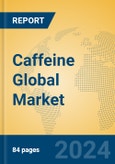The global caffeine market is poised for significant growth owing to the increasing consumption of caffeinated beverages, energy drinks, and dietary supplements. Caffeine is a central nervous system stimulant that is most commonly found in coffee, tea, and various energy drinks. Over the last few years, there has been a rising inclination among health-conscious consumers toward caffeine-infused products, driving market demand. The market is expected to be valued at approximately $4.9 billion by 2029, growing at a CAGR of 6.0% from 2024 to 2029.
Companies are also investing in research and development to innovate caffeine products that offer health benefits without undesirable side effects. DuPont, for example, recently launched a new line of natural caffeine products aimed at enhancing the health profile of beverages.
This product will be delivered within 1-3 business days.
Market Size
In 2023, the global caffeine market was valued at approximately $3.4 billion. The increasing penetration of caffeine in various sectors, including pharmaceuticals, food, and beverages, is expected to propel market growth. Regions such as North America and Europe hold significant market shares, accounting for over 45% of the total caffeine consumption due to strong demand for energy drinks and specialty coffee.Share & Trends Analysis Report
By Products Type
- Natural Caffeine: Dominates the market due to the growing trend towards natural and organic ingredients in consumable products.
- Synthetic Caffeine: While synthetic caffeine is gaining traction due to its cost-effectiveness, a shift towards natural sources is anticipated to affect its market share.
By Key Players
The caffeine market features a number of key players including:- DuPont: Known for its focus on natural and sustainable caffeine sources.
- BASF SE: A significant player in the synthetic caffeine segment owing to its vast distribution network.
- Green Mountain Coffee Roasters: Utilizes natural caffeine in its coffee products, thereby appealing to health-conscious consumers.
- China National Chemical Corporation: A major producer of caffeine for food and beverages.
By Process
- Caffeine Extraction: The extraction of caffeine predominantly occurs from coffee beans and tea leaves, leveraging various methods such as water and solvent extraction.
- Synthesis: Synthetic caffeine is produced through chemical processes wherein urea and malonic acid are combined, used primarily in pharmaceuticals and confectionery.
By Application
- Food and Beverages: This is the largest application segment, driven by the popularity of coffee, energy drinks, and sodas.
- Pharmaceuticals: Caffeine is utilized for its analgesic properties in pain-relief medications.
- Cosmetics: Caffeine is increasingly being incorporated in skincare products for its anti-inflammatory benefits.
By End-Use
- Household: Coffee and tea consumption for personal at-home consumption is a dominant factor.
- Commercial: Coffee shops, cafes, and other establishments contributing to the commercial consumption of caffeine.
By Region
- North America: Leading region, primarily due to high consumption rates of energy drinks and coffee.
- Europe: Following closely behind with significant demand in specialty coffee and dietary supplements.
- Asia-Pacific: Expected to exhibit the highest growth rate, with rising disposable incomes and changing consumer behavior towards caffeinated products.
Market News: Policies and Company Developments
Recent developments in the caffeine market showcase a trend towards sustainability and health consciousness among consumers. Regulatory bodies in many regions continue to focus on caffeine consumption guidelines to ensure consumer safety. In the EU and USA, regulatory authorities are evaluating the caffeine levels in energy drinks due to health implications of excessive consumption.Companies are also investing in research and development to innovate caffeine products that offer health benefits without undesirable side effects. DuPont, for example, recently launched a new line of natural caffeine products aimed at enhancing the health profile of beverages.
Segment Forecasts (2024 - 2029)
Natural vs. Synthetic Caffeine
Natural caffeine is projected to grow significantly during this period, driven by consumer preferences shifting towards organically sourced ingredients, whereas synthetic caffeine may see stagnation as the market focuses on health-oriented products.Regional Insights
The Asia-Pacific region is expected to record the highest growth over the forecast period, attributed to urbanization, growing youth population, and increased spending on health and wellness products.Application Segmentation
The food and beverage segment will continue to be the largest application area, but the pharmaceutical sector is expected to show robust growth due to more healthcare products incorporating caffeine for enhanced performance.Conclusion
The caffeine market is undergoing substantial transformation influenced by health trends, consumer preferences, and innovative applications. As the market is projected to move towards a compound annual growth rate (CAGR) of 6.0%, it signifies robust opportunities for businesses within the caffeine sector to innovate and diversify their offerings. With a conscientious trend towards natural sources, sustainability, and the move towards healthier lifestyle choices, the future landscape of the caffeine market is set for exciting advancements.This product will be delivered within 1-3 business days.
Table of Contents
Chapter 1 Executive SummaryChapter 2 Abbreviation and Acronyms
Chapter 3 Preface
Chapter 4 Market Landscape
Chapter 5 Market Trend Analysis
Chapter 6 Industry Chain Analysis
Chapter 7 Latest Market Dynamics
Chapter 8 Trading Analysis
Chapter 9 Historical and Forecast Caffeine Market in North America (2019-2029)
Chapter 10 Historical and Forecast Caffeine Market in South America (2019-2029)
Chapter 11 Historical and Forecast Caffeine Market in Asia & Pacific (2019-2029)
Chapter 12 Historical and Forecast Caffeine Market in Europe (2019-2029)
Chapter 13 Historical and Forecast Caffeine Market in MEA (2019-2029)
Chapter 14 Summary For Global Caffeine Market (2019-2024)
Chapter 15 Global Caffeine Market Forecast (2024-2029)
Chapter 16 Analysis of Global Key Vendors
List of Tables and Figures
Companies Mentioned
- CSPC Innovation
- BASF
- Shandong Xinhua
- SJZ No.4 Pharmaceutical
- Jilin Shulan Synthetic
- Aarti Industries
- Ahinsha Chemicals
- Anhui Redstar
- Coffein
- CR3 Kaffeveredelung
- Derivados Industrializados del Café SA de CV (Dicafe)
- Stabilimento Farmaceutico Cav. G. Testa (Testa)
- Siegfried Evionnaz








